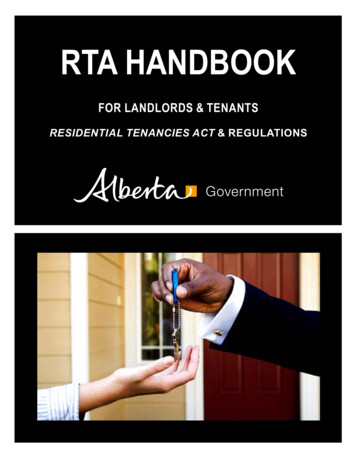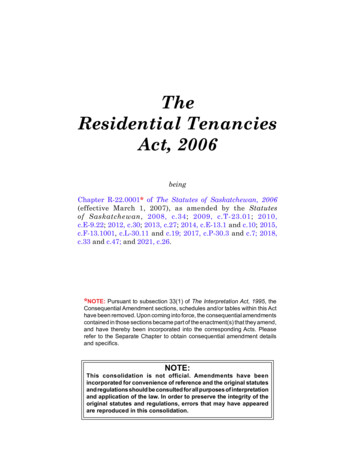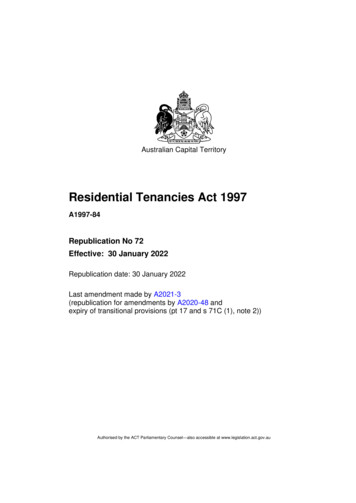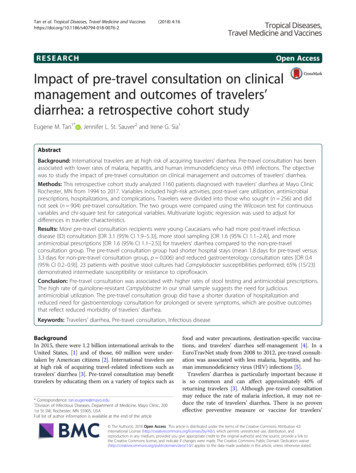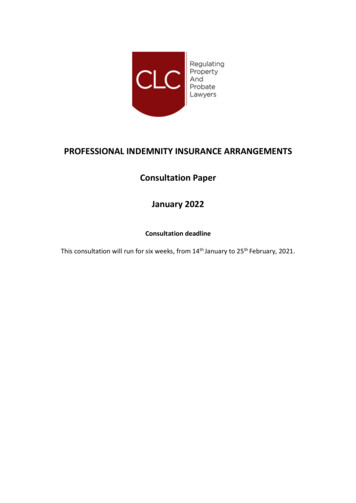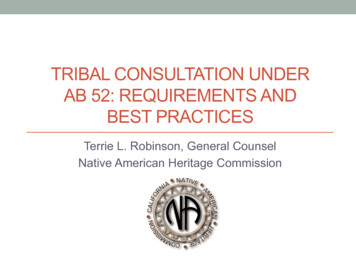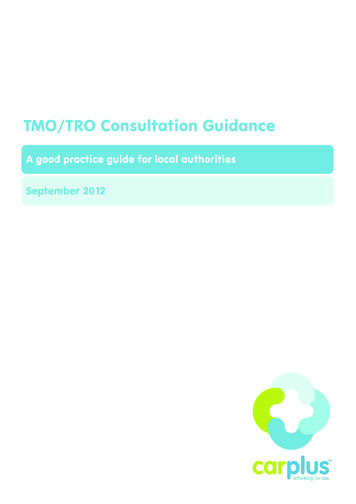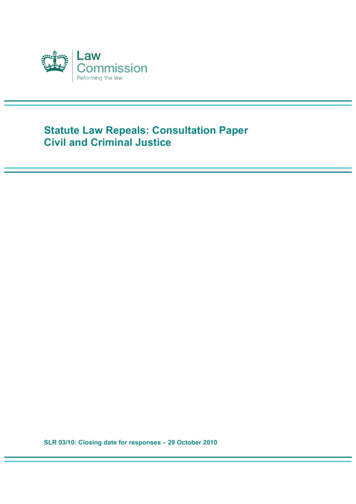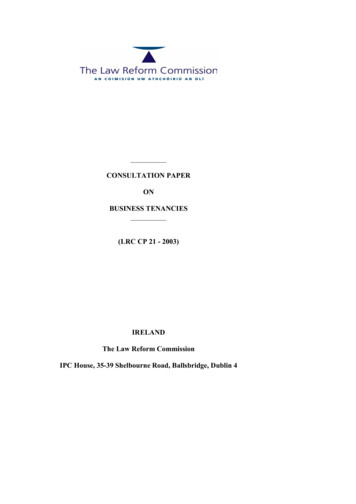
Transcription
CONSULTATION PAPERONBUSINESS TENANCIES(LRC CP 21 - 2003)IRELANDThe Law Reform CommissionIPC House, 35-39 Shelbourne Road, Ballsbridge, Dublin 4
CopyrightFirst PublishedThe Law Reform Commission 2003March 2003ISSN 1393 - 3140ii
THE LAW REFORM COMMISSIONBackgroundThe Law Reform Commission is an independent statutory body whosemain aim is to keep the law under review and to make practicalproposals for its reform. It was established on 20 October 1975,pursuant to section 3 of the Law Reform Commission Act 1975.The Commission’s Second Programme for Law Reform, prepared inconsultation with the Attorney General, was approved by theGovernment and copies were laid before both Houses of the Oireachtasin December 2000. The Commission also works on matters which arereferred to it on occasion by the Attorney General under the terms ofthe Act.To date the Commission has published sixty eight Reports containingproposals for reform of the law; eleven Working Papers; twentyConsultation Papers; a number of specialised Papers for limitedcirculation; An Examination of the Law of Bail; and twenty threeReports in accordance with section 6 of the 1975 Act. A full list of itspublications is contained in the Appendix to this Consultation Paper.MembershipThe Law Reform Commission consists of a President, one full-timeCommissioner and three part-time Commissioners.TheCommissioners at present are:PresidentThe Hon Mr Justice Declan BuddHigh CourtCommissionersPatricia T Rickard-ClarkeSolicitorDr Hilary A Delany, Barrister-at-LawSenior Lecturer in Law, Trinity College Dubliniii
Professor Finbarr McAuleyJean Monnet Professor of European CriminalJustice, University College DublinMarian ShanleySolicitorSecretaryJohn QuirkeResearch StaffLegal ResearchersSimon Barr LLB (Hons), BScClaire Morrissey BCL (Int’l), LLM (K ULeuven)Claire Hamilton LLB (Ling Franc), Barristerat-LawPatricia Brazil LLBNessa Cahill LLB, LLM (Bruges), Barrister-atLawMark O’Riordan BCL, Barrister-at-LawPhilip Perrins LLB, LLM (Cantab), of theMiddle Temple, BarristerDarren Lehane BCL, LLM (NUI)Administration StaffProject ManagerPearse RayelLegal InformationManagerMarina Greer BA, H Dip LISCataloguerEithne Boland BA (Hons), H Dip Ed, H DipLISiv
Higher Clerical OfficerDenis McKennaPrivate Secretary to the PresidentLiam DarganClerical OfficersGerry ShielSharon KineenPrincipal Legal Researchers on this Consultation PaperBrónagh Maher BCL, Barrister-at-LawMark O’Riordan BCL, Barrister-at-LawContact DetailsFurther information can be obtained from:The SecretaryThe Law Reform CommissionIPC House35-39 Shelbourne RoadBallsbridgeDublin 4TelephoneFax NoEmailWebsite(01) 637 7600(01) 637 7601info@lawreform.iewww.lawreform.iev
vi
Landlord and Tenant Law Project GroupIn July 2001, the Law Reform Commission established the Landlordand Tenant Project aimed at reform and consolidation of Landlordand Tenant Law. It engaged the services of Professor JCW Wylie asexpert consultant and leader of a Working Group comprising legalpractitioners with knowledge and experience of this area of the lawand representatives of the Department of Justice, Equality and LawReform and the Department of the Environment and LocalGovernment. Professor Wylie is the author of several standard textson Irish property law, including Irish Landlord and Tenant Law (2nded Butterworths 1998). The other members of the Working Groupare:The Hon Mr Justice Declan Budd, President of the Law ReformCommissionCommissioner Patricia T Rickard-Clarke (Convenor)John F Buckley, Solicitor (former judge of the Circuit Court)Ruth Cannon, Barrister-at-LawJames Dwyer, SCPatrick Fagan, SolicitorErnest B Farrell, SolicitorColin Keane, SolicitorMichael G MacGrath, SCSheila McMahon, Department of the Environment and LocalGovernmentGavin Ralston, SCRegina Terry, Department of Justice, Equality and Law ReformJohn Walsh, SolicitorProfessor David Gwynn MorganBrónagh Maher was Secretary and Legal Researcher to the Groupuntil September 2002, when she was replaced by Mark O’RiordanThe Group has met regularly over the past 18 months, and during thisperiod has refined the scope of the Project, as outlined below. Infurtherance of this, it has concentrated initially on business tenancies,which is the subject of this Consultation Paper.vii
viii
TABLE OF CONTENTSINTRODUCTION .1Scope of Project .1Guiding Principles .5CHAPTER 1BUSINESS TENANCIES IN IRELAND .7CHAPTER 2 OTHER JURISDICTIONS .13General Conclusions .13Statutory Control .15United Kingdom .16England and Wales .17Northern Ireland.22Scotland .24Continental Europe .25Security of Tenure .25Terms of Business Leases.28Restrictions on Alienation .29Other Statutory Interference .29United States of America.29General Common Law of the United States .30Law in New York State .31Law in California .32Australasia .33Security of Tenure .33Terms of Business Leases.34Other Statutory Interference .34CHAPTER 3 FUNDAMENTAL ISSUES.37The Relationship of Landlord and Tenant .37Scope of Statutory Protection .39Contracting-Out .39Position of the State .45Tenement .46The Concept.46Buildings.47Tenancy.48Community of Interest .49ix
Right to a New Tenancy .51Occupation Period.51Term of New Tenancy .52Subletting .52Periodic Tenancies.53Other Equities .55Restrictions on the Right to a New Tenancy .56Compensation for Disturbance .57Compensation for Improvements.60Covenants in Leases.62Scope of Provisions .63Consolidation .65CHAPTER 4 DETAILED POINTS .67Part I of the 1980 Act.67Section 3 .67Section 4 .70Section 5 .70Part II of the 1980 Act .71Section 13 .71Section 14 .73Section 17 .74Section 18 .78Section 19 .78Section 20 .78Section 22 .79Section 23 .79Section 24 .80Section 26 .81Section 27 .82Section 28 .83Part IV of the 1980 Act.84Section 58 .84Section 60 .86Section 61 .87Section 63 .87Part V of the 1980 Act .88Section 64 .88Section 65 .88Section 66 .90Sections 67 and 68 .91Section 69 .92x
Part VI of the 1980 Act.92Section 74 .92Section 78 .92Section 81 .93Section 85 .93Section 87 .93CHAPTER 5APPENDIXSUMMARY OF PRELIMINARYRECOMMENDATIONS.95LIST OF LAW REFORM COMMISSIONPUBLICATIONS .101xi
xii
INTRODUCTIONScope of the Project1Landlord and Tenant Law is a vast area of the law which canbe categorised in a number of ways. One common method is byreference to the nature of the property (usually referred to as“demised premises”) the subject of the tenancy, eg, agriculturaltenancies, residential tenancies and business tenancies. Agriculturaltenancies used to be very common in Ireland but largely disappearedas a consequence of the nineteenth and twentieth centuries’ legislativescheme usually referred to as the “Land Purchase Acts”.1 Under thisscheme, Irish tenants had the freehold vested in them, and their titleswere compulsorily registered in the Land Registry.2 For decades, theculture amongst Irish farming families, ever mindful of past strugglesto acquire ownership to the land they farmed, militated againstrecreation of tenancies. Another factor against creation of tenancieswas that, until recent times, old nineteenth century legislationconferring various rights on agricultural tenants remained on thestatute book.3 The Irish farming community took the view that thepossible impact of this old legislation rendered it sensible to avoidcreating tenancies of agricultural land.4 An attempt to stimulateinterest in agricultural tenancies was made in the 1980s. The LandAct 1984 “disapplied”5 the old nineteenth century legislation just1See Lyall Land Law in Ireland (2nd ed Round Hall 2000) Chapter 15; WylieIrish Land Law (3rd ed Butterworths 1997) paragraph 1. 38 et seq.2Originally under the Local Registration of Title (Ireland) Act 1891; see nowsection 23 (1) (a) of the Registration of Title Act 1964 and Fitzgerald LandRegistry Practice (2nd ed Round Hall 1995) Chapter 24.3Eg provisions in such Acts as the Landlord and Tenant (Ireland) Act 1870and Land Law (Ireland) Acts 1881, 1887 and 1896.4This was the primary reason why the very common practice of makingconacre and agistment “lettings” (which do not create a tenancy of the land)developed: see Wylie, op cit, paragraph 20.25 et seq; also Irish Landlord andTenant Law (2nd ed. 1998) paragraph 3.20 et seq.5The Act does not purport to repeal the old legislation: see section 3 (1).1
referred to in relation to any “lease of agricultural land”6 made afterthe passing of that Act.7 At the same time, certain financialinstitutions8 joined with the Irish Farmers’ Association and otherorganisations9 to promote a “Master Lease” for agricultural land.10Nevertheless, an investigation by the Commission has revealed thatagricultural leases remain comparatively rare, and are usually onlycreated where it is necessary to create a leasehold interest in order totake advantage of some statutory or other official scheme, such as themilk quota or farm retirement schemes. The result is that theCommission has put the subject of agricultural tenancies to one sideand has concentrated on other, more pressing aspects of landlord andtenant law. It is important to emphasise, however, that theCommission will return to this subject, partly because some of thegeneral law, including some statute law,11 clearly applies as much toagricultural tenancies as it applies to other categories. The likelihoodis, then, that the Commission will have a number of recommendationsto make with respect to agricultural tenancies.2Residential tenancies form a very important category withobvious relevance to modern-day methods of occupying property.Notwithstanding the drive in recent decades towards owneroccupation of houses, the huge rise in property prices experienced inthe major urban areas of Ireland over the past decade has resulted inlarge sections of the population being priced out of the market. Thedemand for residential property available for letting is strong, and islikely to remain so in the foreseeable future. This is an area of thelaw which has long been the subject of legislative control. Indeed,the original Rent Acts were enacted nearly a century ago12 and,6This means “any instrument in writing (whether under seal or not) containinga contract of tenancy in respect of land used wholly or mainly for thepurpose of agriculture, horticulture or forestry”: section 3(2).7Ie 16th December 1984.8Eg Allied Irish Banks.9The Law Society and Royal Institution of Chartered Surveyors.10Cf The Irish Auctioneers and Valuers Institute Long Term Agricultural LandLease.11An obvious example, reflecting the era in which it was enacted, is “Deasy’sAct” (Landlord and Tenant Law Amendment Act, Ireland 1860).12As part of the scheme introduced at Westminster at the beginning of the FirstWorld War: see Increase of Rent and Mortgage Interest (Restrictions) Acts1915-1919 (consolidated in the Increase of Rent and Mortgage Interest(Restrictions) Act 1920): see Coghlan Law of Rent Restriction in Ireland (3rd2
although envisaged as a temporary scheme, it took on a permanentstatus in subsequent decades.13 Over time, the extent of rent controlreduced and, by the 1980s, when aspects of the legislation weredeclared unconstitutional by the Supreme Court, probably no morethan 15% of the total private rented sector came with it. The newlegislative scheme, introduced in 1982, applies to a decliningproportion of the sector. In 1999, the Minister for Housing and UrbanRenewal established a Commission on the Private Rented ResidentialSector, with a broad remit to examine the working of the landlord andtenant relationship in respect of residential tenancies in the privaterented sector. Particular issues to be addressed were: improvingsecurity of tenure of tenants of dwellings; maintaining a fair andreasonable balance between the respective rights and obligations oflandlords and tenants; increasing investment in, and the supply of,residential accomodation for renting. It reported in July 2000,14 andthe Government accepted most of its proposals,15 which are now inthe course of implementation.16 For obvious reasons, the LawReform Commission accepts that it would be inappropriate for itsProject Group to review matters covered by the 2000 Report and theprojected legislation. It must, however, be recognised that there aremany aspects of landlord and tenant law applicable to residentialproperty which are not so covered. This includes large areas of thegeneral law (both common law and statute law) and speciallegislation, such as the ground rents legislation.17 The Commissionwill, in due course, subject this to detailed examination, but, notsurprisingly, it has concentrated first on the third main category oftenancies.3Business tenancies came to be recognised as a discrete area oflandlord and tenant law towards the end of the nineteenth century,when the issue of special legislation to protect business tenants wased 1979) at 1-3.13Following the Report of the Black Tribunal - Agreed Report of the TownTenants (Occupational Tenancies) Tribunal (1941), the major enactmentswere the Rent Restrictions Acts 1946 and 1960.14Report of the Commission on the Private Rented Residential Sector(Department of the Environment and Local Government July 2000).15Press Release 5 January 2001.16A Housing (Private Rented Sector) Bill is in the course of drafting, but hasnot yet been introduced to the Oireachtas.17Landlord and Tenant (Ground Rents) Acts 1967-1987: see Wylie op citChapter 31.3
debated. Enactment of such legislation was recommended by aBritish Parliamentary Committee in 1889.18 This was not acted uponat Westminster for England and Wales, but was, in fact, for Ireland inthe form of the Town Tenants (Ireland) Act 1906.19 The 1906 Actwas subsequently replaced by the Landlord and Tenant Act 1931,20and this, in turn, was eventually replaced by the Landlord and Tenant(Amendment) Act 1980.21 That Act has since been amended onseveral occasions, as a result of review by the Landlord and TenantCommission, chaired by Judge Charles Conroy22 and, more recently,the Law Reform Commission.23 However, this has, for the most part,resulted only in piecemeal changes to the details of the schemeoriginally laid down in the 1931 Act. Doubts have continued to beexpressed as to whether the scheme now accords with the significantchanges which have occurred in the Irish business and commercialenvironment in recent times. Furthermore, the legislative schemenow comprises a complex jumble of Acts of the Oireachtas, which arenot easy to access and understand. The Commission has examinedthis subject in considerable detail, and the result of its deliberations isset out in this Consultation Paper.4It is important to reiterate that the categorisation of landlordand tenant law by reference to the nature of the property is only one,albeit convenient, method of categorisation. The Commission will,on occasion, adopt other categorisations. For example, anothermethod is by reference to the source or derivation of the law, wherebya distinction is often drawn between the common law (as largelydeveloped over the centuries by the courts) and statute law. Furthersub-categorisation may be appropriate. For example, statute law canbe sub-divided. Some statute law is specific, in the sense that it isconfined to and dealing with a particular area of landlord and tenantlaw or type of tenancy. Examples have already been referred to such18Report on the Select Committee on Town Holdings.19Legislation for England and Wales did not occur until the enactment of theLandlord and Tenant Act 1927.20See Hughes and Dixon, Landlord and Tenant Act 1931 (1932); Moore andOdell, Landlord and Tenant Act 1931 (Falconer 1932).21See Wylie op cit Chapter 30.22See further Chapter 1 below.23The latest amending Act was the Landlord and Tenant (Amendment) Act1994, which was based, to some extent, on recommendations contained inthe Law Reform Commission’s Report on Land Law and ConveyancingLaw: (1) General Proposals (LRC 30-1989) Chapter 5.4
as the ground rents legislation and rent restriction/private renteddwellings legislation. Other statute law is more general in character,in that its application tends to cover most, if not all, types of tenancy,whatever the nature of the property. Good examples of this areDeasy’s Act 1860 and the various provisions governing leases in theConveyancing Acts 1881-1911. All this will be the subject of reviewby the Project Group, and the Commission will publishrecommendations in due course.Guiding Principles5It may be useful at this stage to state the guiding principlesadopted by the Commission in carrying out its work. The overall aimis to produce a legislative scheme which draws a fair balance betweenthe interests of landlords and tenants. Particular attention will be paidto the issue of whether there is a continuing need for legislativeinterference in private contractual arrangements. In the context ofcommercial property, regard must be had to the business environmentin which landlords and tenants have to operate. A primaryconsideration should be ensuring that the law, particularly in the formof legislation, does not force landlords and tenants into arrangementswhich suit neither group. Statutory control and protection should beconfined to situations where there is an obvious need, such as wherethere is a substantial risk that one party may take unfair advantage ofthe other. These broad aims should be furthered by achieving thefollowing objectives:(1)Removal of obsolete provisions, including ancient legislation;(2)Removal of legislative provisions which militate againstcommercial practice and operation of free market choice, so asto facilitate creation of agreements free of unintended andunforeseen consequences;(3)Recasting legislative provisions which create uncertainties orhave proved to be ambiguous;(4)Introducing new provisions to meet what are perceived to begaps in existing law;5
(5)Consolidating existing legislation (together with any newprovisions to be introduced) in order to make the law muchmore accessible and easily understood.Outline of this Consultation Paper6This Paper begins in Chapter 1 with an outline of the currentlaw relating to business tenancies, as enshrined in the legislativescheme comprising the Landlord and Tenant (Amendment) Acts 1980,1984, 1989 and 1994. Chapter 2 then outlines, by way of contrast, theposition in other jurisdictions, in particular the United Kingdom andother parts of Europe. Chapter 3 considers some fundamental issueswhich the Commission considers underpin much of the existing law,such as: the scope for “contracting-out” of the legislative scheme;entitlement to statutory rights; the position of the State; restrictions onstatutory rights and compensation provisions. Chapter 4 drawsattention to numerous detailed, but nonetheless significant, doubts,uncertainties and other apparent flaws in the existing legislativescheme. Both Chapter 3 and Chapter 4 contain the Commission’sprovisional recommendations for changes in the scheme.The Consultation Process7This Consultation Paper is intended to form the basis ofdiscussion, and the recommendations in it are provisional only. TheCommission will make its final recommendations on this topicfollowing further consideration of the issues and consultation withinterested parties. They are likely to be incorporated in a Reportcovering the whole scope of the Project as outlined above, and whichmay be based partly on the response to other Consultation Paperswhich may be issued in due course.Submissions on therecommendations included in this Consultation Paper are welcome, asthey will greatly assist the Commission in their further deliberations.To that end, those who wish to do so are requested to make theirsubmissions in writing to the Commission by 30 June 2003.6
CHAPTER 1BUSINESS TENANCIES LAW INIRELAND1.01 The principle of conferring statutory protection on tenantsoccupying property, including business premises, in the urban areasof Ireland1 gained currency in the latter half of the nineteenth century.Irish MPs made several, but unsuccessful, attempts to persuade theWestminster Parliament to enact appropriate legislation.2 When,eventually, they did succeed at the beginning of the twentieth century,the British Government of the day insisted upon watering down theprovisions in question. In particular, the Bill which was enacted asthe Town Tenants (Ireland) Act 19063 did not include the provisionsin the original draft giving tenants a right to renewal of expired leasesat rents to be fixed, in default of agreement, by the court,4 or,alternatively, a right to purchase the freehold at a price to be fixedagain, in default of agreement, by the Court. Instead, the 1906 Actsimply contained provisions for compensation for improvementsmade by tenants,5 and for disturbance on termination of a tenancy.61.02 The general view seems to have been that even the limitedprovisions of the 1906 Act were flawed. For example, the amounts of1Hitherto, most attention had been focussed on the position of agriculturaltenants, and much of the nineteenth century legislation related to suchtenants.2See Rents and Leasehold Commission Report on Reversionary Leases underthe Landlord and Tenant Acts (Pr 2532 1954) Chapter 2; Ground RentsCommission Report on Ground Rents (Pr 7783 1964) Chapter 2.3For commentary on this Act see eg Lehane and Coles Town Tenants (Ir) Act1906 (1906); Clery, Kennedy and Dawson Town Tenants (Ir) Act 1906(1913).4In those days the County Court.5Ie tenants using premises in towns and villages wholly or partly for businesspurposes: see sections 1-4 and 13.6These provisions applied to business tenants wherever the premises weresituated: see sections 5 and 7.7
compensation7 awarded for disturbance by the courts have beendescribed as “absurdly small,” and, by the time of the establishmentof the State, the view was taken that the Act was largely a deadletter.8 Pressure for reform was exhibited in Dáil Éireann,9 andeventually, in January 1927, a Commission, under the chairmanshipof Mr Justice Meredith was appointed to inquire into the lawgoverning the relationship of landlord and tenant in respect of“holdings in urban districts, towns and villages”. Its final report,presented on 27 April 1928, recommended, in essence, that theprinciples of statutory protection conferred on agricultural tenantsduring the nineteenth century should be adopted for urban tenants.Those principles were known as the “Three Fs”, viz a fair rent, freesale and fixity of tenure.10 These recommendations were acted uponwith the enactment of the Landlord and Tenant Act 1931, whichrepealed the Town Tenants (Ireland) Act 1906.111.03 It is important to note that much of the 1931 Act applied tourban tenants generally, ie, whether occupying their premises forbusiness or residential purposes.12 This Consultation Paper isconcerned with the provisions of particular relevance to businesstenants, which fall into three main categories. First, a statutory rightto a new tenancy on determination of the old one was conferred, withthe terms, including the rent, to be fixed by the Court in default of7Compensation could only be awarded where the landlord had refused torenew a lease without “good and sufficient” cause: see O’Leary v Deasy[1911] 2 IR 450; Samuels v O’Brien (1914) 48 ILTR 249; Haughton v Ross(1915) 49 ILTR 72.8Rents and Leasehold Commission, op cit, paragraph 21. A more favourableview of the Act’s operation seems to have been taken in the North: seeReport of the Departmental Committee on the Law of Landlord and Tenant(Cmd 96 1929); Dawson Business Tenancies in Northern Ireland (SLS LegalPublications (NI) 1994) Chapter 1.9Bills to apply the protection conferred by nineteenth century legislation onagricultural tenants to urban tenants (of both residential and businesspremises) were promoted by Captain W Redmond TD: Bills No 13 of 1924and No 42 of 1926.10They were finally enshrined for agricultural tenants in the Land Law(Ireland) Act 1881: see Wylie Irish Land Law (3rd ed Butterworths 1997)paragraph 1.47 et seq.11Section 9 of the Landlord and Tenant Act 1931.12See Hughes and Dixon Landlord and Tenant Act 1931 (1932); Moore andOdell Landlord and Tenant Act 1931 (Falconer 1932).8
agreement by the parties.13 Secondly, where, under the Act, thelandlord was entitled to refuse a new tenancy on certain grounds,14the tenant would be entitled to compensation for disturbance.15Thirdly, again where a tenant had
Higher Clerical Officer Denis McKenna Private Secretary to the President Liam Dargan Clerical Officers Gerry Shiel Sharon Kineen Principal Legal Researchers on this Consultation Paper Brónagh Maher BCL, Barrister-at-Law Mark O'Riordan BCL, Barrister-at-Law Contact Details Further information can be obtained from: The Secretary
